
Project Gutenberg's Lexington and Concord, by Samuel V. Chamberlain
This eBook is for the use of anyone anywhere in the United States and most
other parts of the world at no cost and with almost no restrictions
whatsoever. You may copy it, give it away or re-use it under the terms of
the Project Gutenberg License included with this eBook or online at
www.gutenberg.org. If you are not located in the United States, you'll have
to check the laws of the country where you are located before using this ebook.
Title: Lexington and Concord
A Camera Impression
Author: Samuel V. Chamberlain
Release Date: July 17, 2018 [EBook #57529]
Language: English
Character set encoding: UTF-8
*** START OF THIS PROJECT GUTENBERG EBOOK LEXINGTON AND CONCORD ***
Produced by Stephen Hutcheson and the Online Distributed
Proofreading Team at http://www.pgdp.net


THE TAP ROOM, BUCKMAN TAVERN

STATUE OF CAPTAIN JOHN PARKER LEXINGTON COMMON
Henry H. Kitson, Sculptor
A CAMERA IMPRESSION
by SAMUEL CHAMBERLAIN
Hastings House Publishers New York
Copyright, 1939, by Samuel Chamberlain. Printed in the United States of America
SET BY HAND IN GARAMOND TYPE BY ELAINE RUSHMORE AT THE GOLDEN HIND PRESS, MADISON, N. J.
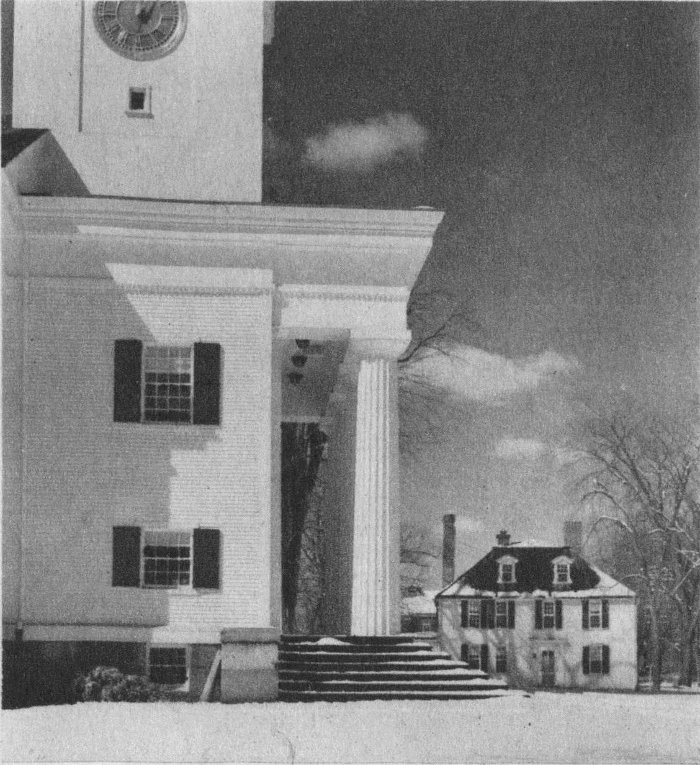
CONCORD WINTER

REVOLUTIONARY ROADSIDE
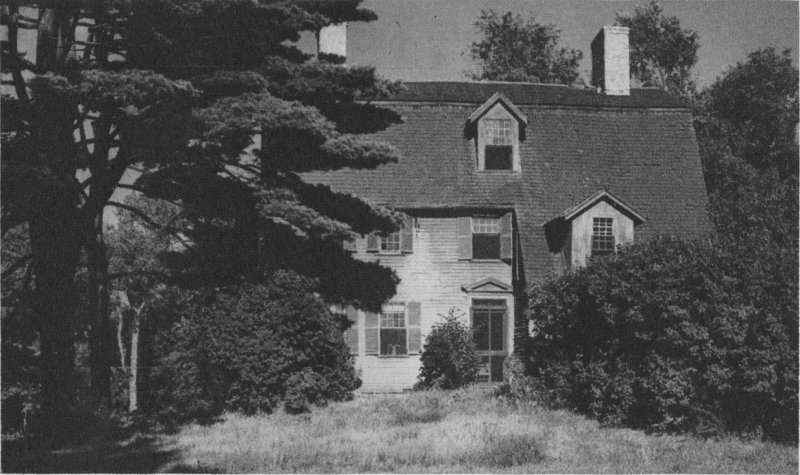
THE OLD MANSE (1769), CONCORD
Every American, since his early school days, has been definitely conscious of the two tranquil New England towns which share the distinction of being the birthplace of the American Revolution. Their story has been told so well and so often, in prose, poetry and historical writing, that this small volume would have scant raison d’être if it were not for the fact that good pictures of Lexington and Concord are curiously rare.
Visual reminders of those stirring days still exist in surprising number all over this countryside. The scenes of the heroic stands made by the minutemen on Lexington Common and at Concord Bridge have been preserved virtually unchanged, thanks to the vigilance of patriotic citizens. The buildings most intimately associated with the epochal events of April 19, 1775 are still in place, to add their eloquent testimony to the story that every schoolchild knows so well. Even more personal are the homes of Concord’s authors, which remain to give a graphic insight into the days of the 19th century when Concord was a significant center of American culture. Spared the unlovely intrusion of factories by their inland sites, these calm townships have kept their rural beauty. Their natural landscape remains unblemished, a pure joy today as it was in Thoreau’s time.
Historical importance here is matched by physical beauty, a fact which strikes every visitor forcibly, and which this little book strives to prove by a series of photographic impressions. These have been taken in all seasons of the year, to portray the varied moods of the countryside. The pictures follow a path approximating the march of the British on that historic morning of April 19, 1775. Beginning in the neighborhood of East Lexington and the Munroe Tavern, on the eastern outskirts of Lexington, they progress to the Battle Green and the Hancock-Clarke house in Lexington, then along the Battle Road through Lincoln, and finally down Concord’s legendary streets, ending at Concord Bridge where the British fired the “shot heard round the world.”
Visitors who have had the enriching experience of following a similar path come away with an inspired picture of this epic moment in American history. These pages do not attempt to record the familiar written story of Lexington and Concord, but they do aspire to capture a fragment of this inspired picture, as it exists today.

ON LEXINGTON COMMON
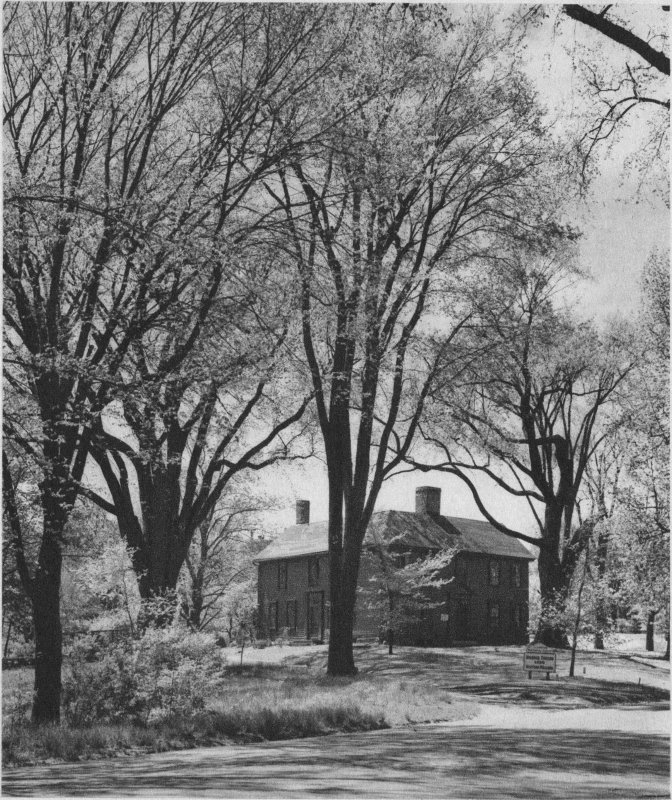
THE MUNROE TAVERN (1695), LEXINGTON,
EARL PERCY’S HEADQUARTERS ON APRIL 19, 1775

The Munroe Tavern
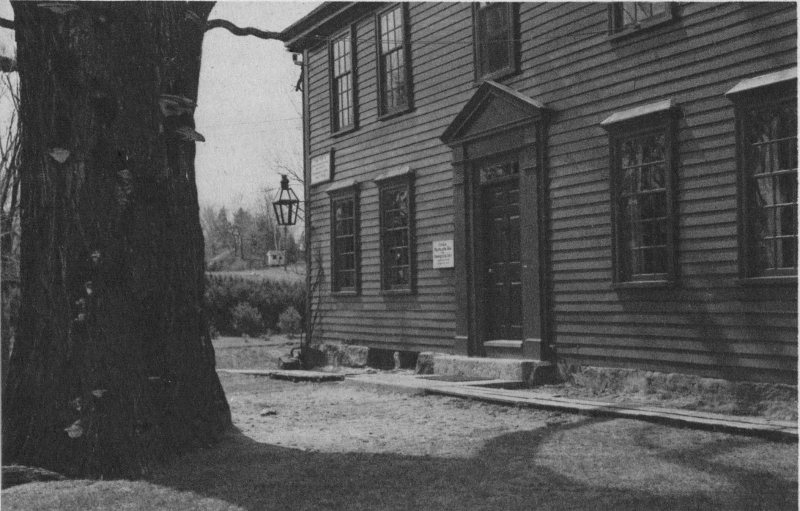
and Detail of the Newly Restored Facade
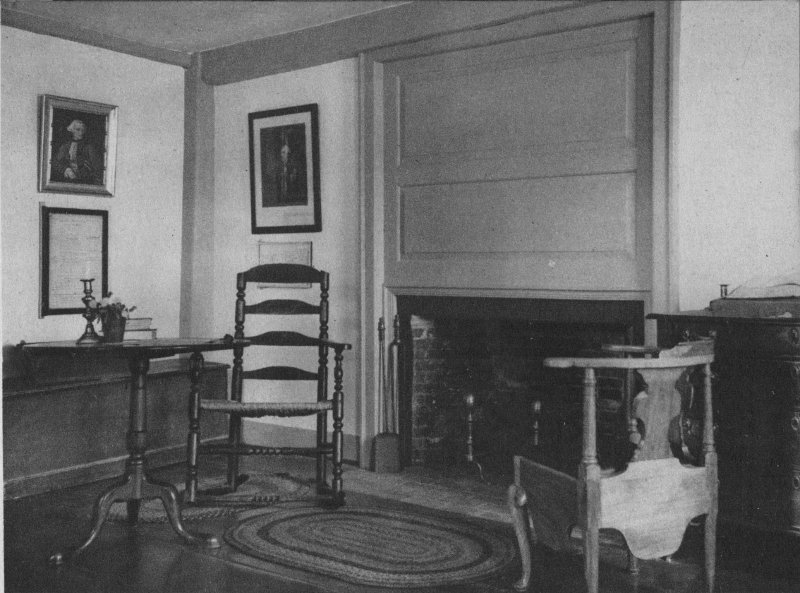
A CORNER OF THE EARL PERCY ROOM, MUNROE TAVERN
The Munroe Tavern, built in 1695, was occupied by Earl Percy when he reached Lexington with reinforcements on the afternoon of April 19, 1775. The old hostelry was used as a hospital and headquarters for the British while the landlord, Sergeant William Munroe was playing his part with the minutemen, and his wife and children were hiding fearfully in the woods. Sergeant Munroe left the tavern in charge of a crippled neighbor, John Raymond, who was shot.
The room above was originally the dining room, and is now dedicated to Earl Percy and filled with a rich collection of Revolutionary relics. The facade of the tavern was altered when it became a private residence, and it has only recently been restored to its former character, from data revealed in an old etching.

THE BARROOM, MUNROE TAVERN
The barroom of the Munroe Tavern contains, among other relics, the remains of a British bullet hole in the ceiling and the original tavern sign, cut out of one piece of hard white pine, which hung outside the door.
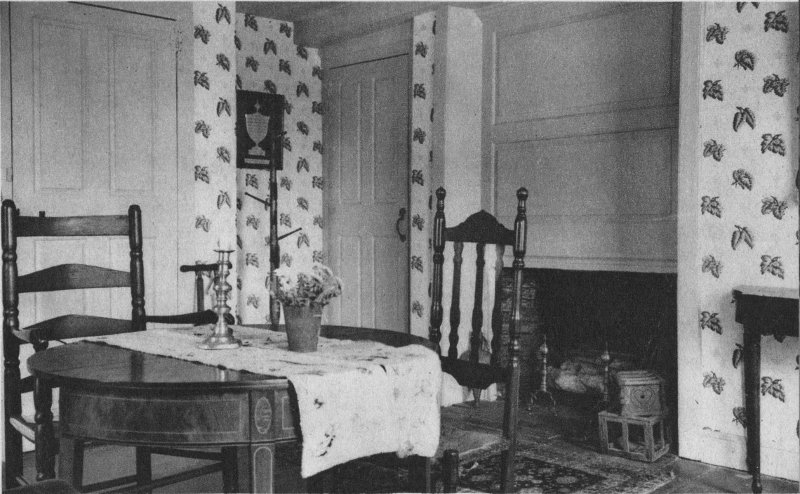
THE WASHINGTON ROOM, MUNROE TAVERN
George Washington dined at the Munroe Tavern on November 5, 1789. The landlord, then Colonel Munroe, cleared this bedchamber and arranged it as a private dining room for the distinguished guest. Washington sat in the chair at the left. The Sheraton table and the hat rack are the same ones used by him. The dishes used for the occasion are also preserved.

A Corner of the Old Bedroom of the Munroe Tavern
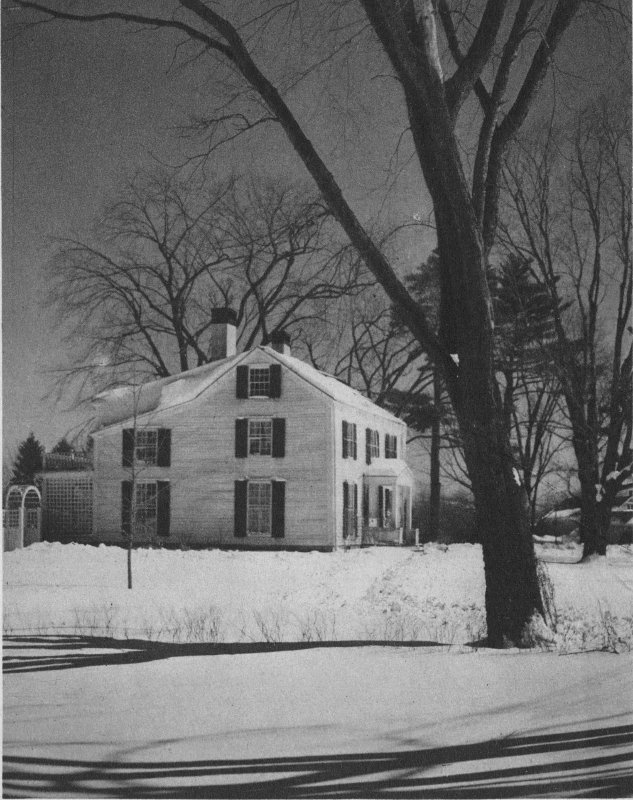
The Mason House (Built 1680) Is across the Road from the Munroe Tavern

Springtime Sycamores over an Old East Lexington House
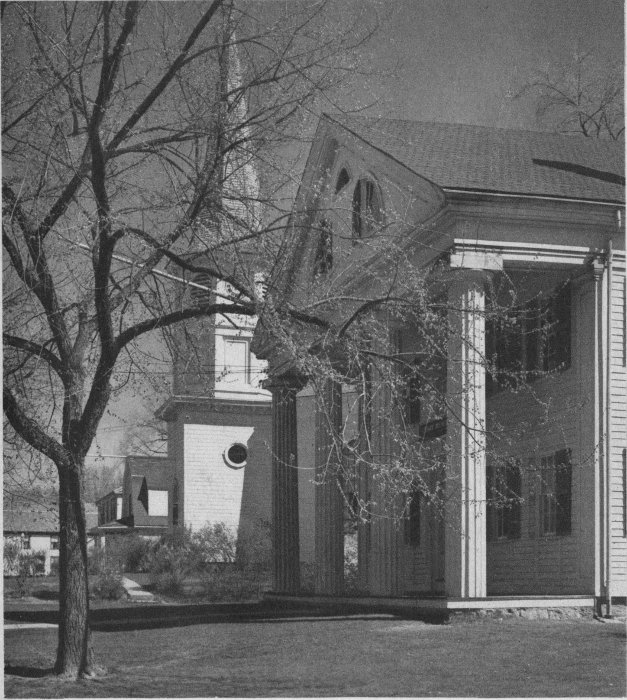
THE FOLLEN CHURCH (1840), EAST LEXINGTON VILLAGE
East Lexington village was reached by the British at early dawn on the 19th of April. It was here that Benjamin Wellington was captured and disarmed by British scouts, the first armed man to be taken in the Revolution. Most of East Lexington’s buildings now date from later periods.

MODERN LEXINGTON—THE CARY MEMORIAL BUILDING
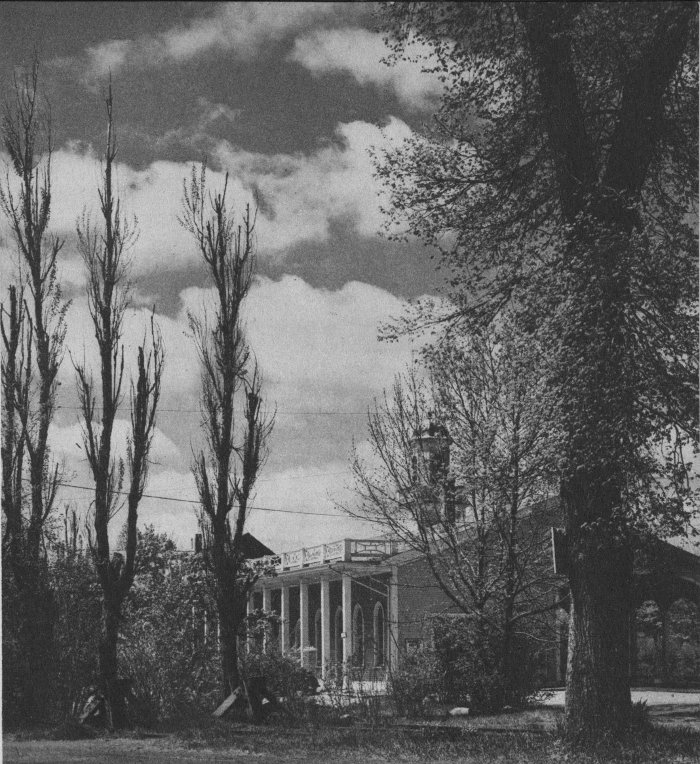
MODERN LEXINGTON—THE RAILWAY STATION
Much of the architecture of modern Lexington reflects its distinguished past. The railway station, for example, is in the chaste Colonial tradition. So is the Cary Memorial Building (1928) which serves as a Town Hall. Among other paintings it contains the famous canvas of the Battle of Lexington, “The Dawn of Liberty,” by Henry Sandham.

STATUE OF CAPTAIN JOHN PARKER, COMMANDER OF THE MINUTEMEN
Henry H. Kitson, Sculptor
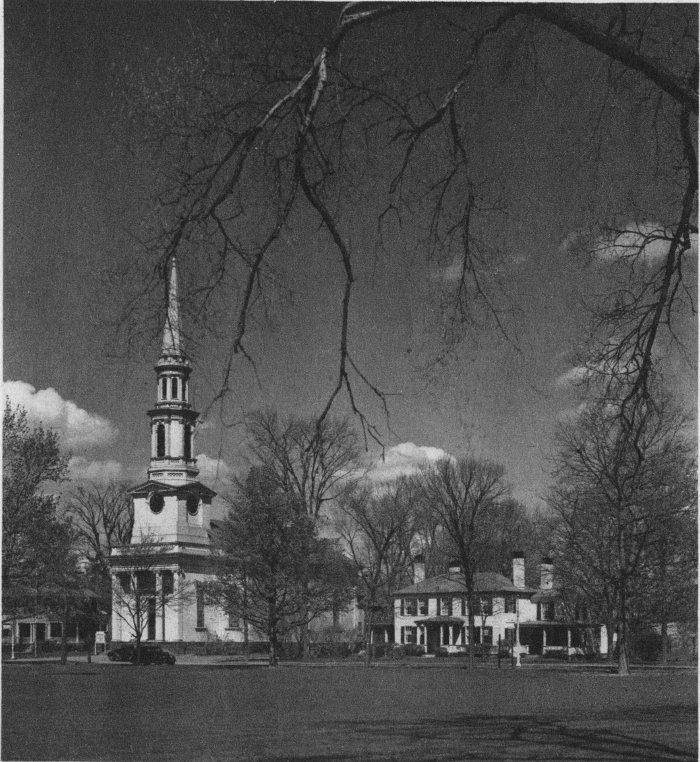
THE BATTLE GREEN—LEXINGTON COMMON
On this triangular village green, “Birthplace of American Liberty,” the little group of embattled minutemen under Captain John Parker faced an advance guard of four hundred British regulars in the pale dawn of April 19, 1775.

THE HOUSE OF MARRETT AND NATHAN MUNROE, LEXINGTON COMMON
This house, built in 1729, was a mute witness of the stirring resistance of the minutemen. Nathan Munroe was a member of Captain Parker’s company.
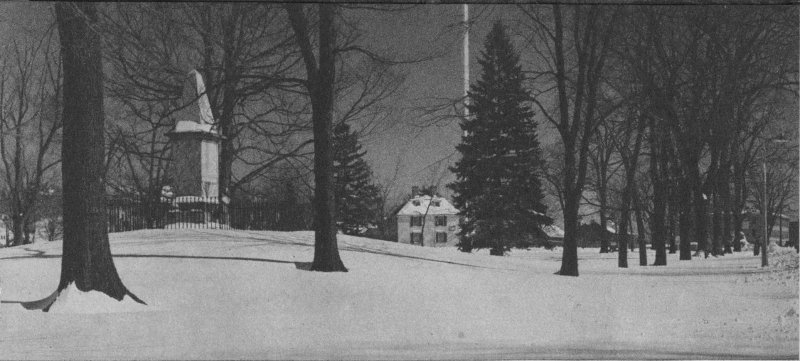
THE BATTLE GREEN IN MID-WINTER
At the left is the first Revolutionary monument to be erected, dedicated to the memory of the men killed at the Battle of Lexington. Their remains are still kept in a tomb at the rear of the granite shaft. Washington and Lafayette both visited this spot.
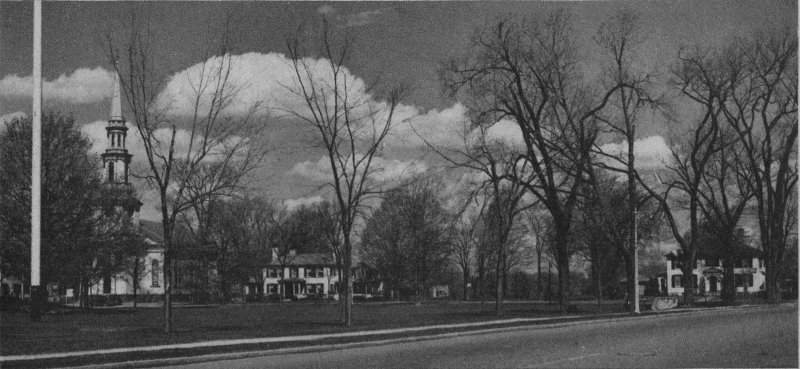
SPRINGTIME ON THE BATTLE GREEN
The view shows the location of the line where the minutemen made their heroic stand. The First Parish Church, facing the Green, dates from 1847, the previous church having occupied a site on the Common itself.

DOORWAY OF THE JONATHAN HARRINGTON HOUSE
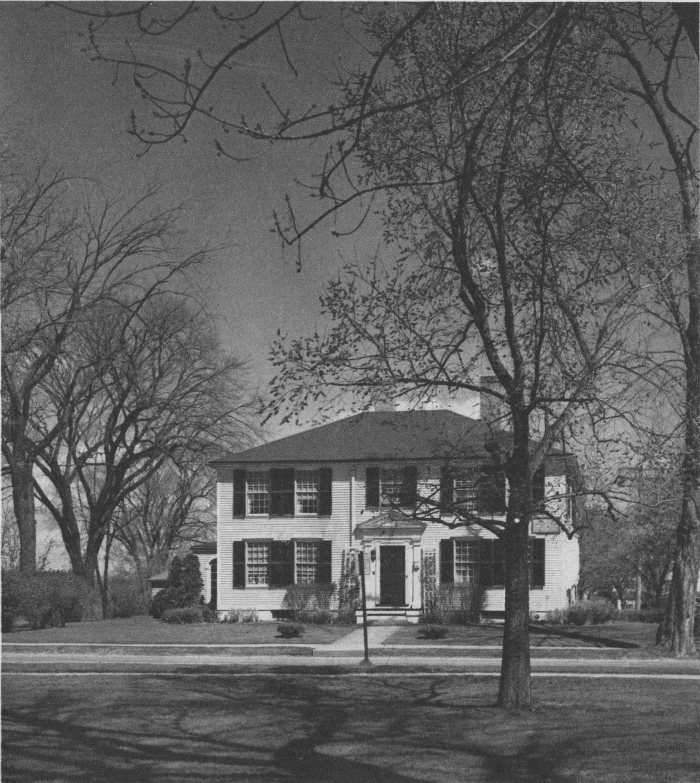
THE HOUSE OF JONATHAN HARRINGTON, LEXINGTON COMMON
Jonathan Harrington, one of the minutemen wounded by British bullets, dragged himself to the doorway of his house facing the Battle Green and died there at his wife’s feet.

THE BOULDER ON LEXINGTON COMMON
Marking the line established by the minutemen on the morning of April 19, 1775. On it are inscribed the words of Captain Parker’s immortal command: “Stand your ground. Don’t fire unless fired upon, but if they mean to have a war let it begin here.”
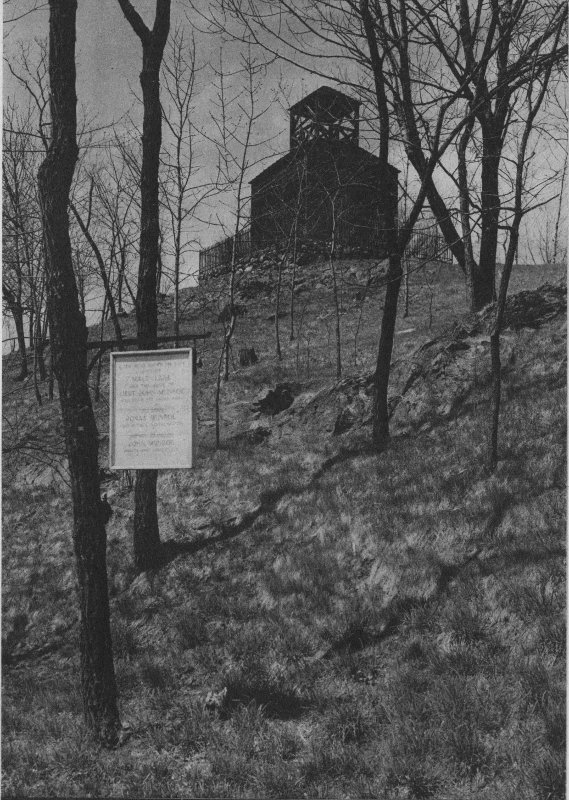
THE OLD BELFRY
To hold the town bell, a little wooden building was erected on a hill overlooking the Common in 1761. A few years later it was moved to the Common, where it sounded the alarm to the minutemen on the morning of April 19th. An exact reproduction of the old belfry has now been erected on the original site. The bell has long since vanished, but its tongue is still preserved.

A WINTRY DETAIL OF THE BUCKMAN TAVERN
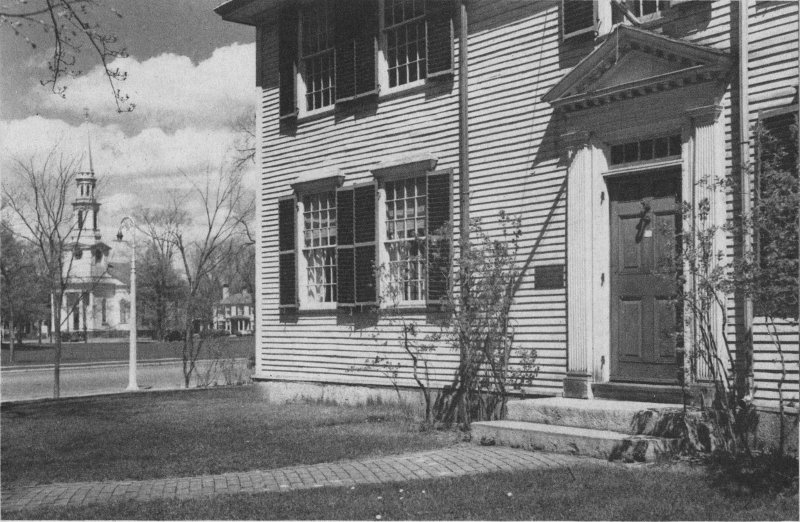
THE BUCKMAN TAVERN (1690), MEETING PLACE OF THE MINUTEMEN, Lexington Common
This old tavern was the scene of great activity on that memorable morning. Around the great fireplace in the tap room the minutemen gathered to await word of the British advance. Paul Revere witnessed the arrival of the British from a chamber window. In the afternoon of April 19th two wounded British soldiers were given first aid here. One of them died shortly after, and was buried in the old cemetery. The Buckman Tavern, which was the oldest of Lexington’s twelve inns, still contains scars of British bullets. The first village store was located here, and later, in 1812 it held Lexington’s first Post Office. The building contains many noteworthy exhibits besides the famous tap room, and is now in the care of the Lexington Historical Society.

THE BUCKMAN TAVERN IN CONTRASTING SEASONS
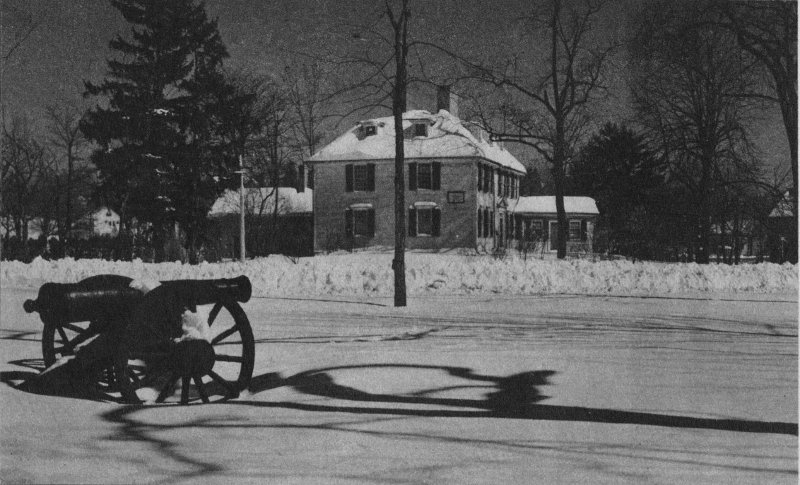
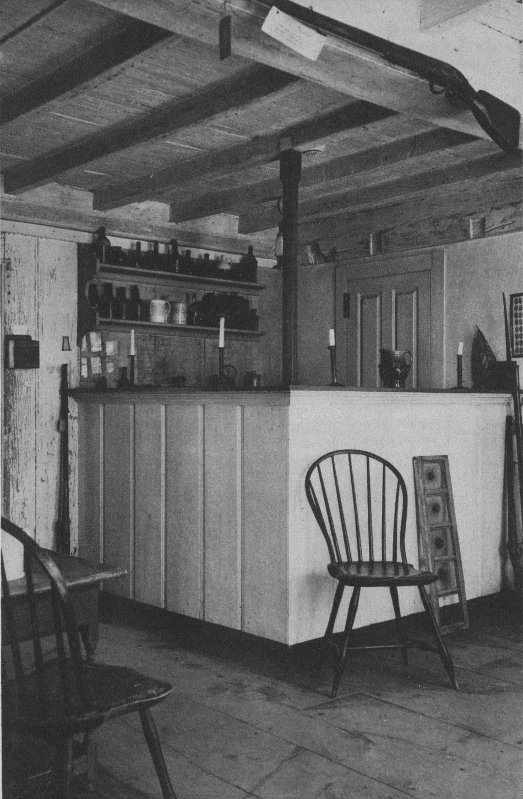
Bar in the Tap Room of the Buckman Tavern

The Tap Room of the Buckman Tavern
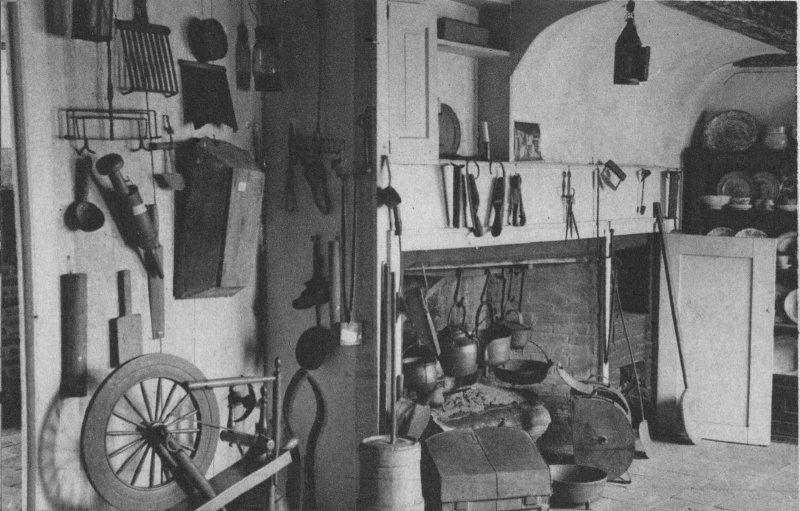
and an Adjoining Fireplace
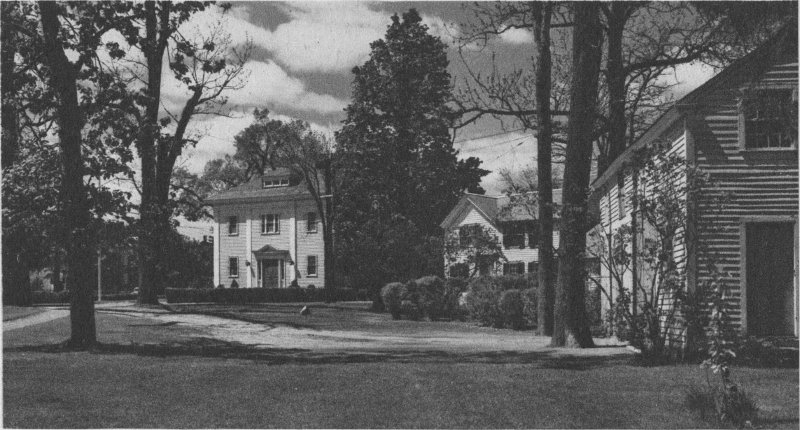
THE FIRST NORMAL SCHOOL IN AMERICA
Standing at the end of Lexington Common is this large frame building, originally constructed for the short-lived Lexington Academy. In 1839 the first Normal School in America was opened here with an enrollment of three pupils. The building now serves as the Masonic Temple.

A Corner of the Old Burial Ground, Lexington
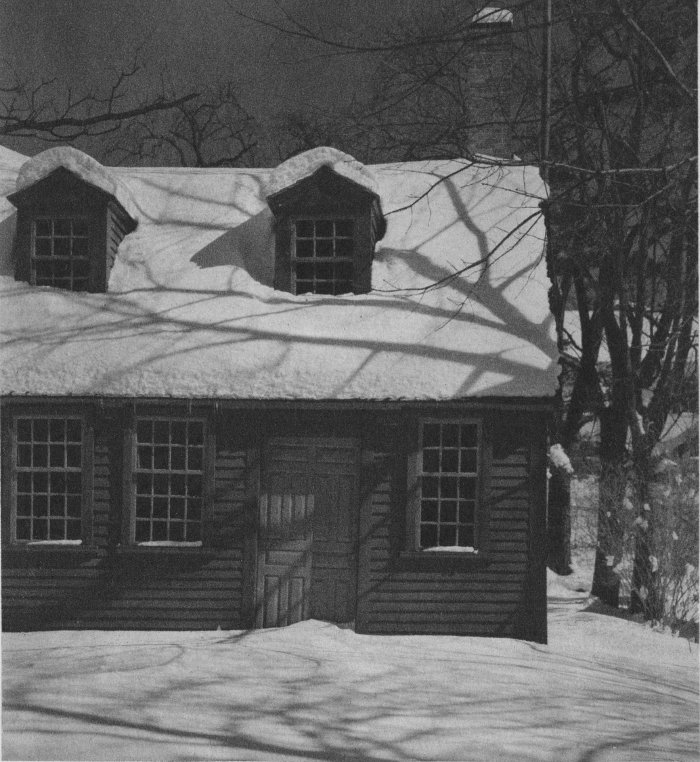
The Original Wing (1698) of the Hancock-Clarke House—Lexington
A wintry view of the gambrel-roofed ell of Lexington’s most celebrated dwelling. It was built as a parsonage in 1698 by the Reverend John Hancock, grandfather of the governor. In its tiny rooms the parson’s five children were raised to maturity.

THE HANCOCK-CLARKE HOUSE IN A SNOWY SETTING
The frame of the original wing is of hand hewn oak, still in fine condition. Thomas Hancock, second son of the parson, who became a prosperous Boston merchant, added the front portion to the house in 1734. John Hancock, the future Governor and signer of the Declaration of Independence, spent several of his boyhood years with his grandparents. The third pastor of the village was a much respected man, Reverend Jonas Clarke. He occupied the house in 1755 and was still its host on April 18, 1775 when John Hancock and Samuel Adams, facing imprisonment if they were caught by the British, took refuge there. John Hancock’s aunt and his fiancee, Dorothy Quincy, were also staying in the house. During the night the two patriots were roused from their sleep by Paul Revere, and were conducted to Burlington for their safety. Dorothy Quincy followed the party, bringing along a fine salmon which had been sent in for their dinner.
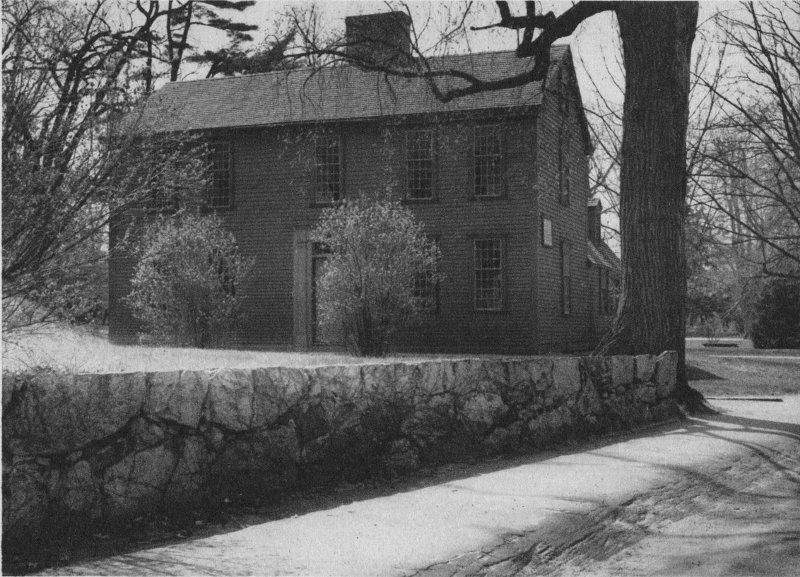
THE HANCOCK-CLARKE HOUSE
The Lexington Historical Society purchased the house in 1896, moved it across the street from its original site and restored it to its original condition. The larger part of the Society’s extraordinary collection of historic relics is exhibited in this house and in a fireproof wing.

The Newer Part of the Hancock-Clarke House (1734) Is Rich in Fine Panelling, Fireplaces and Revolutionary Relics
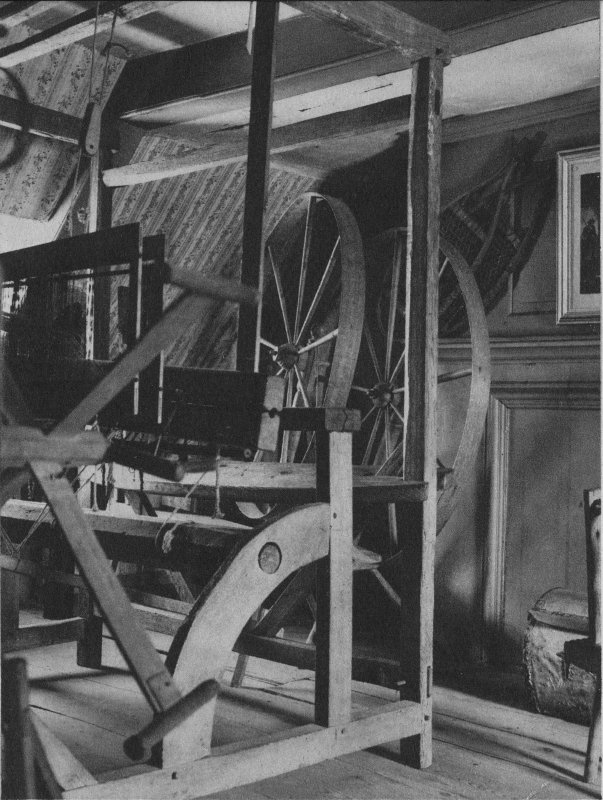
Attic Atmosphere under the Low Gambrel of the Hancock-Clarke House

AUTUMN AT THE HARTWELL FARM
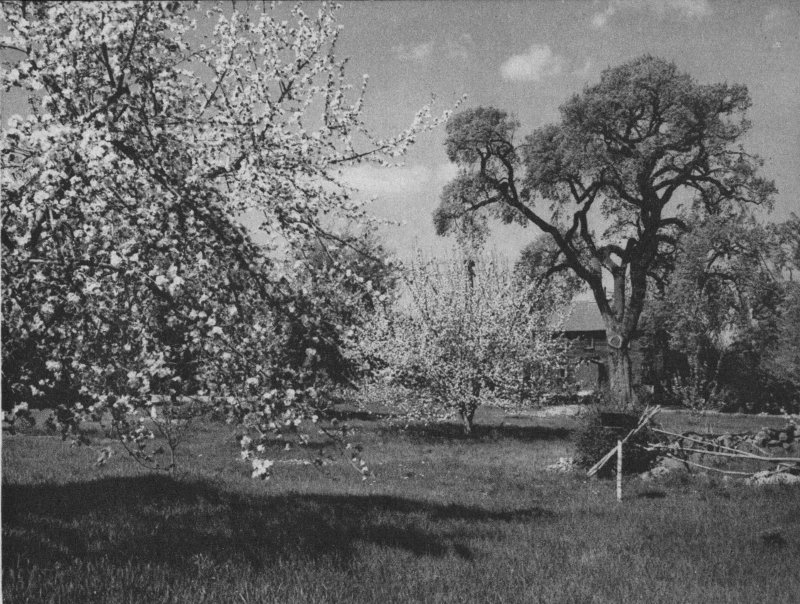
ALONG THE BATTLE ROAD—THE HARTWELL FARM IN LINCOLN
The route of the British from Lexington to Concord led through the town of Lincoln along a wooded highway. It was at a bend in this road, about two o’clock in the morning, that the midnight ride of Paul Revere ended. In company with William Dawes and Dr. Samuel Prescott, Paul Revere was halted by a British patrol. Dawes escaped, as did Dr. Prescott, who went on to give the alarm at Concord, but Revere was arrested and taken back to Lexington. There he was released, and later joined John Hancock and Samuel Adams.
The Samuel Hartwell house, now known as the Hartwell Farm, is one of the survivors along the Battle Road. Past its front door the red-coated Grenadiers matched with smart precision on the morning of April 19th. They returned in the afternoon, with broken ranks and no semblance of military order, harassed by the minutemen. One Grenadier pushed his broken musket through a window of the house and left it there, and several fired bullets into its boarded facade.

Farmhouse along the Battle Road
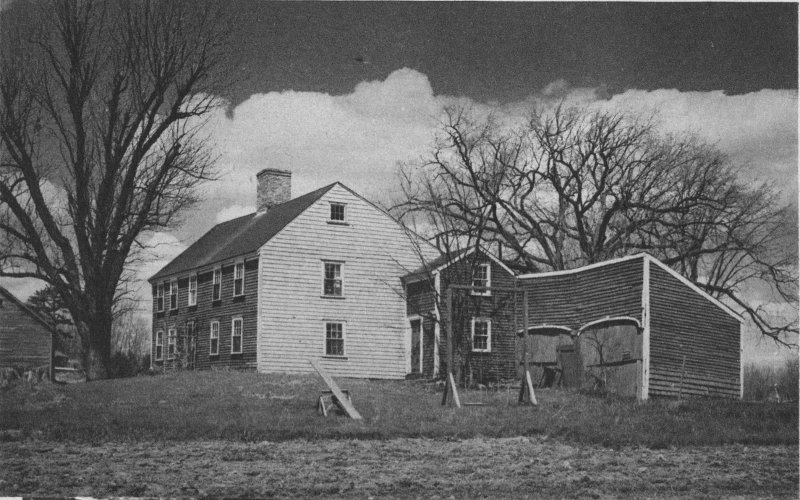
The Farm at Meriam’s Corner
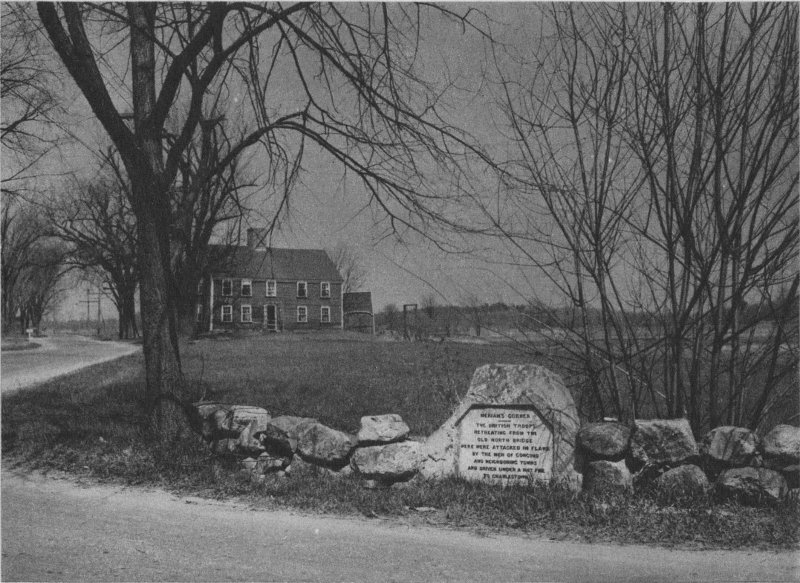
MERIAM’S CORNER, CONCORD
The first point of interest encountered in Concord marks, not the British approach but their retreat, after the rout at North Bridge. Here, at Meriam’s Corner, the minutemen who had fought at the bridge were joined by embattled farmers from Sudbury, Framingham and other neighboring towns. From all sides they poured fire on the retreating Regulars, finally driving them all the way to Boston.

THE FERTILE FIELDS OF CONCORD, SCENE OF THE BRITISH RETREAT
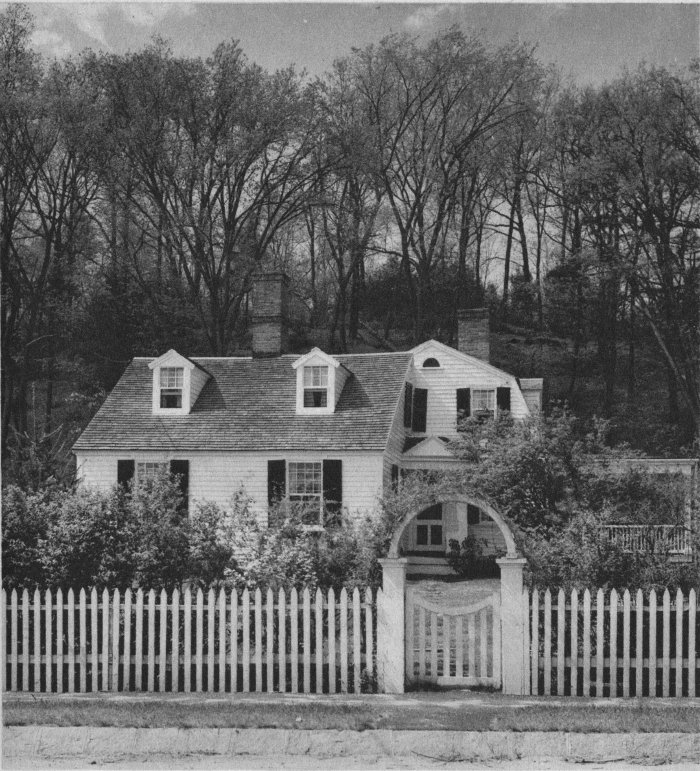
GRAPEVINE COTTAGE, CONCORD
Along Lexington Road in Concord begins a succession of interesting buildings, the first of which is this cottage, the home of Captain Ephraim Wales Bull, who bred and developed the Concord grape here in the 1840’s. A shoot from the root of the original Concord grapevine still prospers under the trellis.

“THE WAYSIDE,” HOME OF THREE AUTHORS, CONCORD
A wintry view of the first of Concord’s literary shrines along Lexington Road. Bronson Alcott gave the house the name of “Hillside” during his stay from 1845 to 1848. Louisa and her sisters spent a few impressionable years of their girlhood here, and gave their plays in the barn. Nathaniel Hawthorne bought the house from the Alcotts in 1852, renamed it “The Wayside” and lived here until his death in 1864. As a refuge from visitors, Hawthorne built a tower, or “sky parlor,” where he wrote “Tanglewood Tales” and “The Marble Faun.” A later owner was Mrs. Daniel Lothrop who, under the name of “Margaret Sidney,” wrote many volumes of the “Five Little Peppers” during her forty years’ residence here. The house dates from the early 18th century.
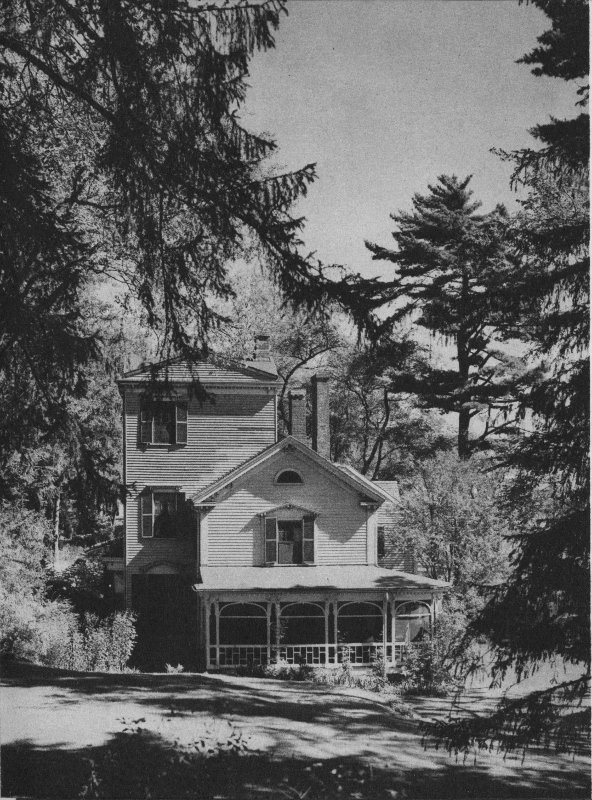
SIDE VIEW OF “THE WAYSIDE,” SHOWING HAWTHORNE’S “SKY PARLOR”

ORCHARD HOUSE, THE HOME OF THE ALCOTTS, CONCORD
After leaving “The Wayside” the Alcott family moved into this old house, at the time considered unfit to live in, and repaired and painted it themselves. Louisa May Alcott affectionately referred to it as “Apple Slump,” and it was here that she wrote the first part of “Little Women.” Much of the Alcott furniture and many books, pictures, and personal memorials are still to be seen in the house, among them the sketches May drew on the walls of her room.
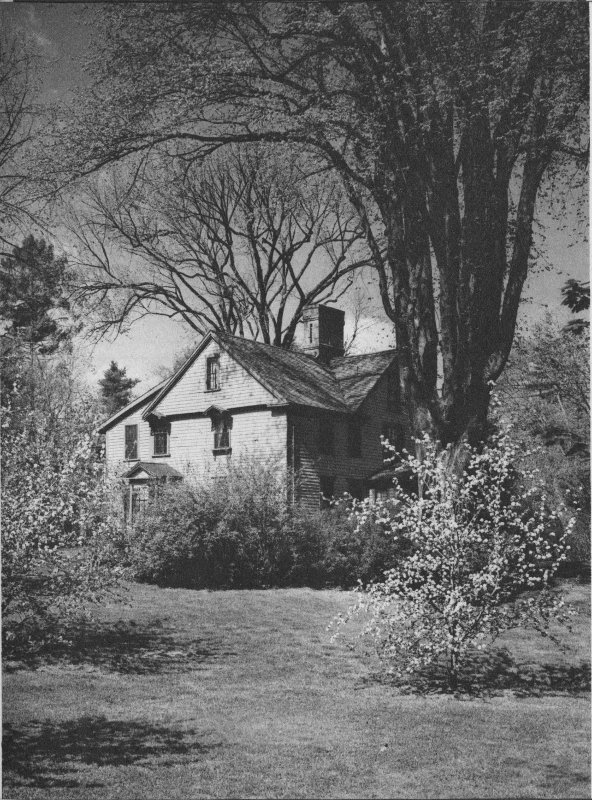
ORCHARD HOUSE AND ITS GIGANTIC ELM, IN EARLY SPRING

The School of Philosophy, Gathering Place of American Philosophers, Concord
On the grounds of Orchard House stands this small unpainted, wooden-Gothic building, once known as Hillside Chapel, which served as Bronson Alcott’s summer school of philosophy for almost a decade. Many notable men of letters came to this chapel, which occupies an important place in the history of American thought.
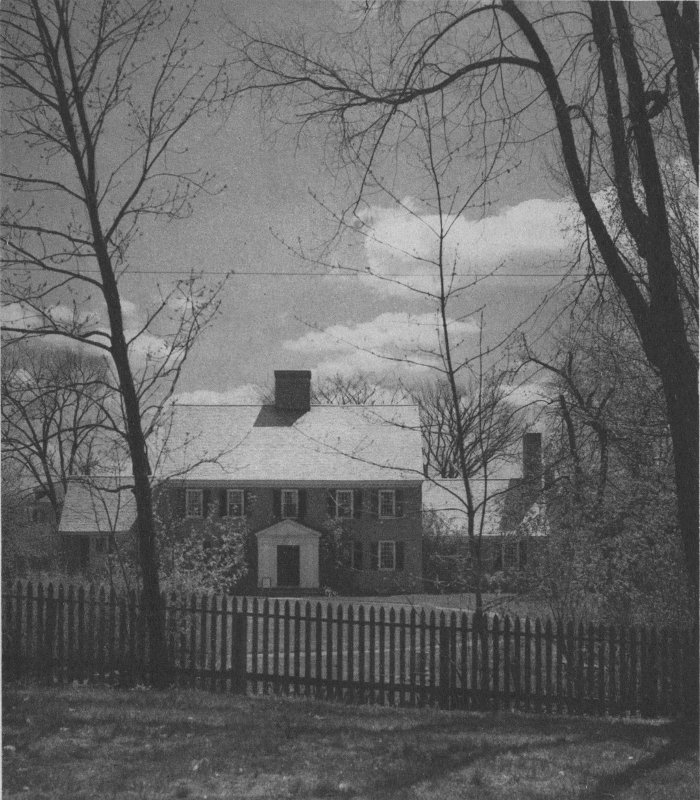
ANTIQUARIAN HOUSE, CONCORD
This building incorporates a noteworthy collection of period rooms, beautifully furnished. The next four pages give glimpses of this significant museum of early American decoration.

A Typical New England Living Room, Late 17th Century
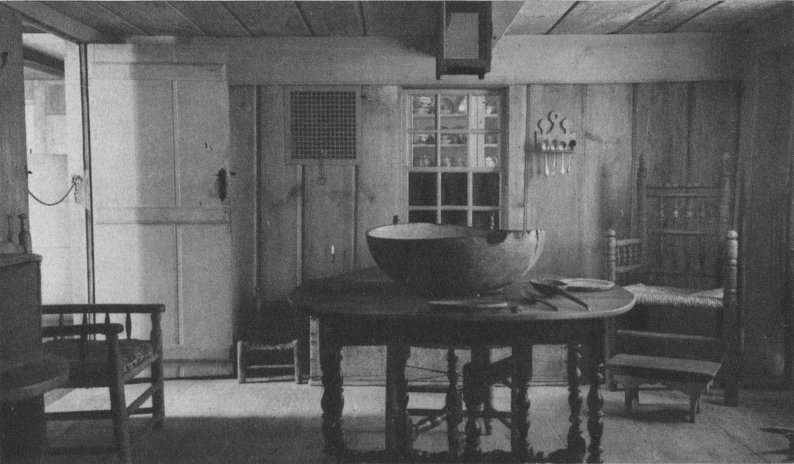
The Pine-ceiled Room, a Rare Survivor from the Early 18th Century
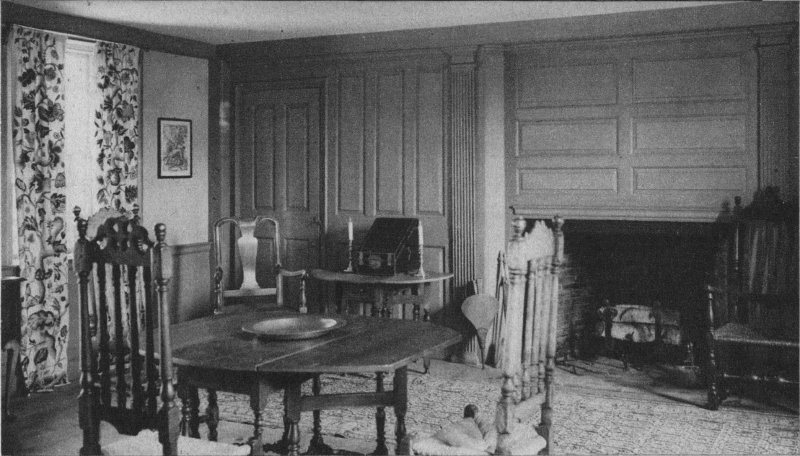
The Green Room Has Irregular Panelling Typical of the Early 18th Century
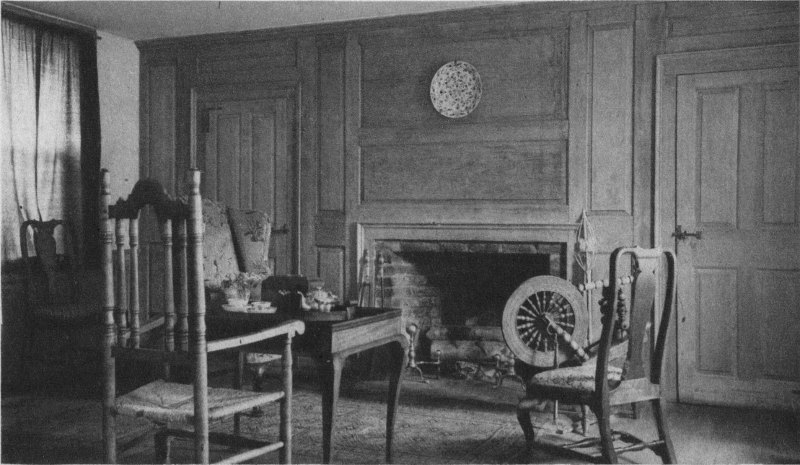
The Queen Anne Room Portrays a More Formal Mode of Living, Middle 18th Century

The Chippendale Room Reflects the Comfortable Days before the Revolution
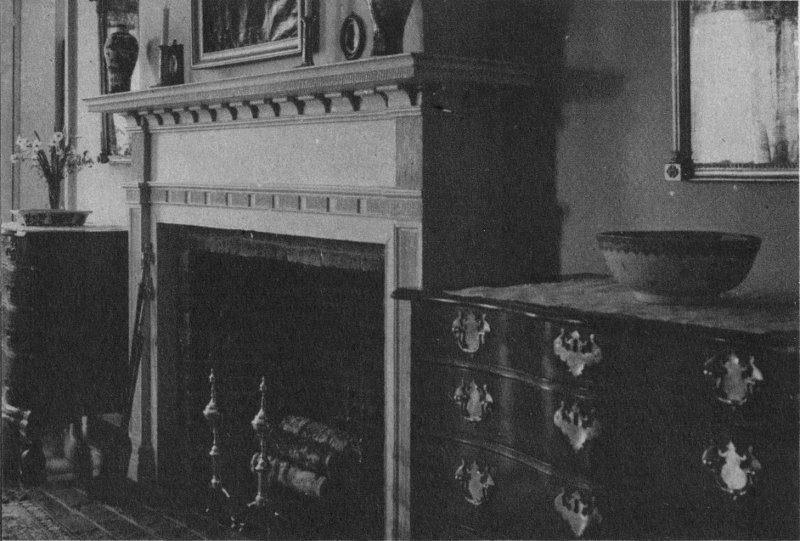
Fireplace Detail from the Reeded Room (period of 1800)
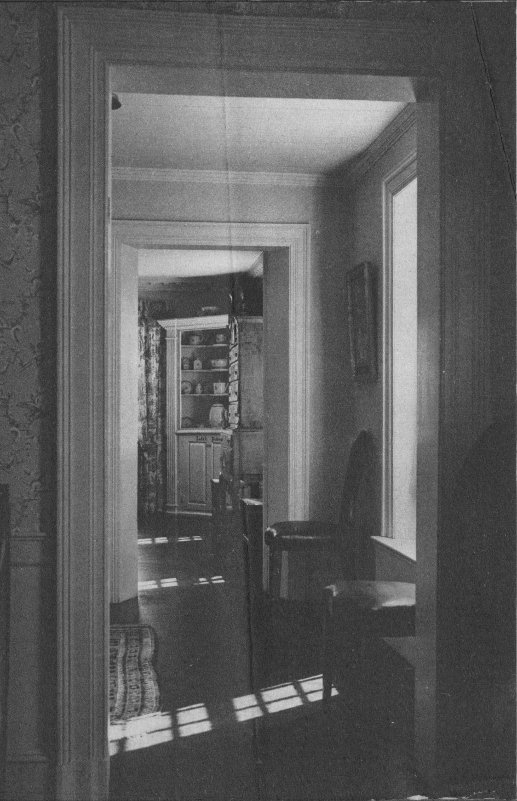
A Glimpse through the Front Hallway into the Reeded Room

THE EMERSON HOUSE, CONCORD
Ralph Waldo Emerson, who built this square white house and planted the pines around it, lived here from 1835 until his death in 1882. During his European tour, Thoreau lived in the house. Emerson was a strong influence in drawing other writers to Concord, and a long succession of visitors to his doorstep. His study has been moved intact, with its books and pictures and furniture, to the fireproof quarters of the Antiquarian House across the way. The other rooms remain much as they were in Emerson’s day.
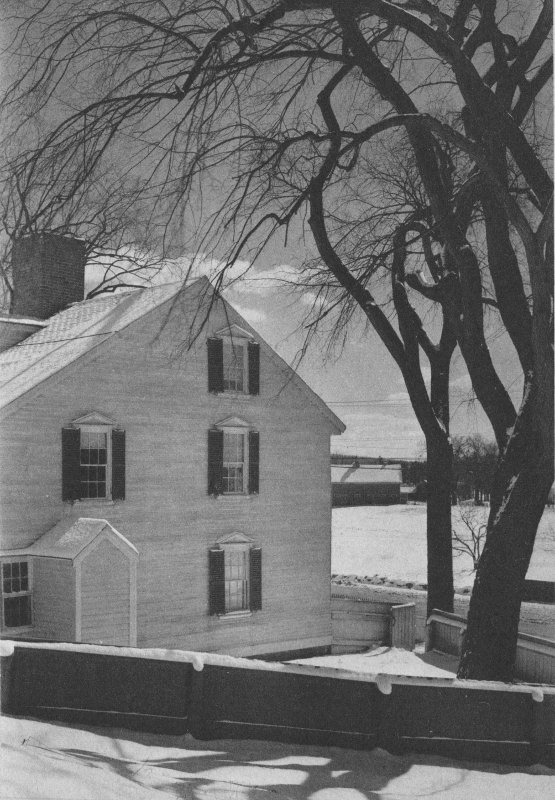
CONCORD SNOWSCAPE

THE REUBEN BROWN HOUSE, CONCORD
Home of the minuteman and saddler who brought back the news of the firing in Lexington. This is now the Old Mill Dam Inn.
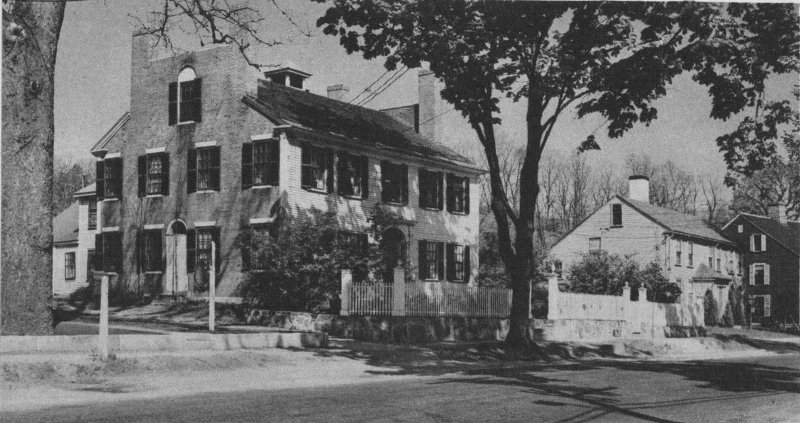
THE CONCORD SUMMER SCHOOL OF MUSIC
A four-chimneyed “brick-ender,” an architectural style rare outside of Concord.
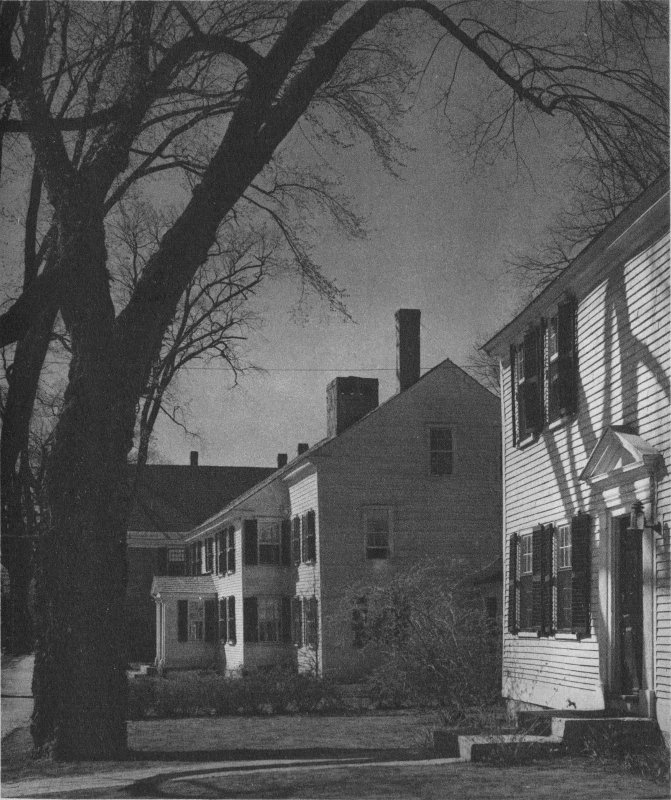
The Concord Art Association Occupies a Noble Old White Clapboard House

LEXINGTON ROAD, CONCORD
A glance backward at the houses just passed on the preceding pages.
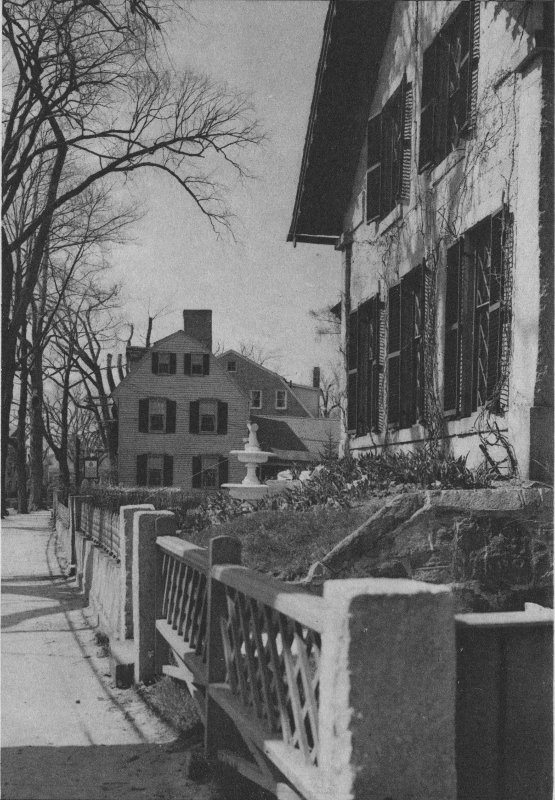
The Victorian Gothic Era Left Concord with This Unusual Stone House
In the distance is the Old Chapter House of the D. A. R.

FIRST PARISH CHURCH, CONCORD
Built in 1901 on the site of the old church where the first and second Provincial Congresses sat, with John Hancock presiding.
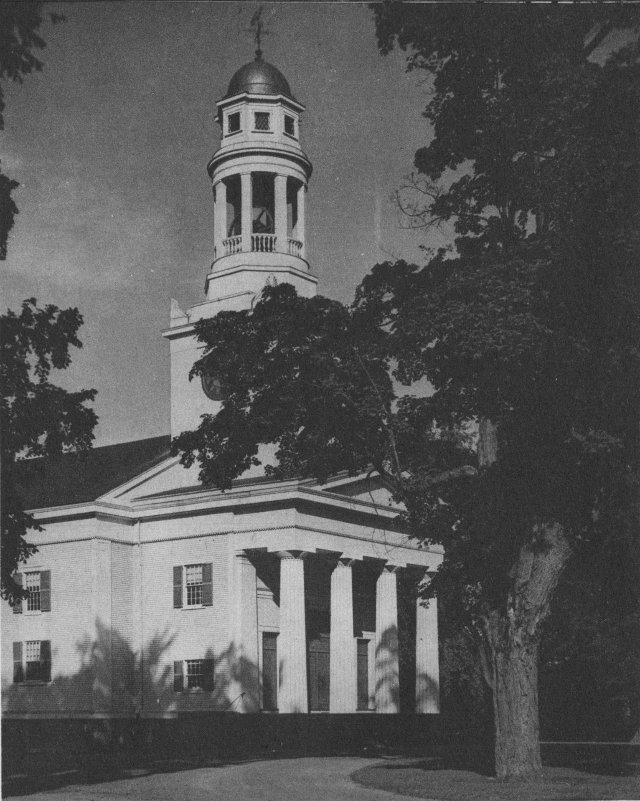
FIRST PARISH CHURCH, CONCORD, IN A SUMMER SETTING
The tree in the foreground went down in the hurricane of September, 1938. Concord was a heavy sufferer in the catastrophe.

ENTRANCE TO THE HILL BURYING GROUND
Across the street is Wright’s Tavern (built in 1747), the British headquarters on April 19, 1775 where Colonel Smith boasted that he would stir the blood of the Yankee rebels.
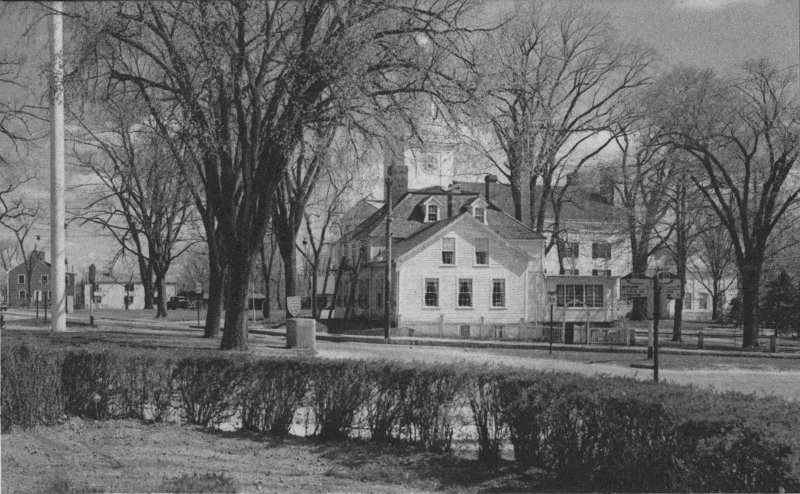
SPRINGTIME ON THE CROSSROADS
The focal point in Concord where the Mill Dam, Concord Square and Lexington Road meet.
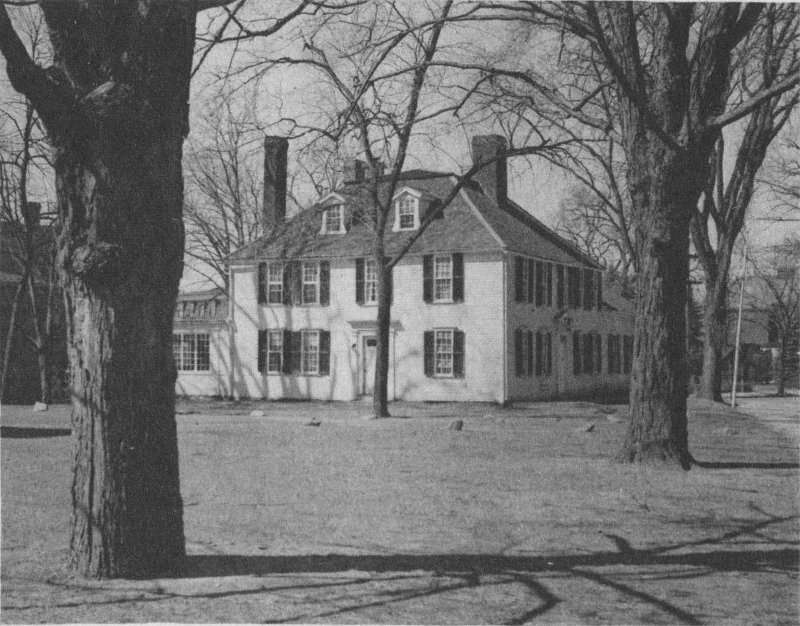
Wright’s Tavern, the oldest existing tavern in Concord, is still run as a hostelry.

THE COLONIAL INN, CONCORD
At the end of Monument Square is this historic inn, dating from 1770 and still thriving. It is composed of three old houses joined together. The building on the extreme left was a Revolutionary store-house, while the wing in the foreground was once a Thoreau residence. The old tap room is still intact, and many relics of the Revolution are still in evidence.
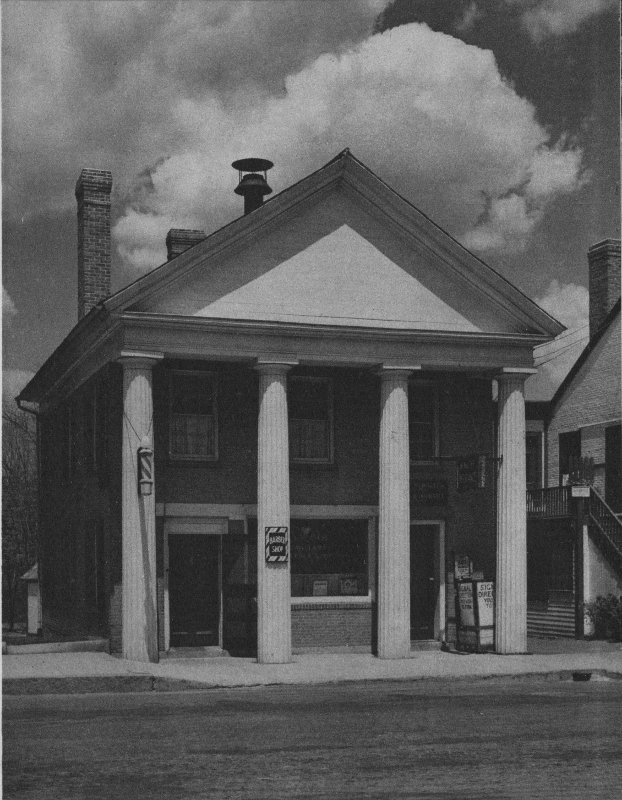
A TEMPLE OF COMMERCE ON THE MILL DAM
The business heart of Concord received the name of the “Mill Dam” due to the fact that it was the site of a dam for almost two centuries. Some of its buildings still retain a fine old Colonial character.

MODERN CONCORD
The Colonial tradition is reflected in many newer buildings, such as the bank on the previous page.
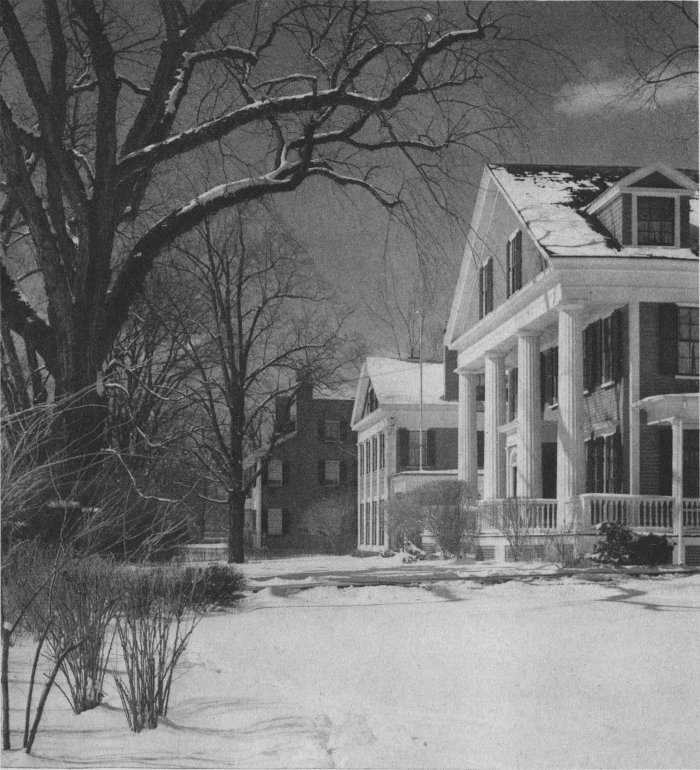
CONCORD ACADEMY IN MIDWINTER

SLEEPY HOLLOW CEMETERY
On this far ridge in Concord’s burial ground are found the graves of the literary great, Emerson, Hawthorne, the Alcotts, Thoreau, and their respective families.
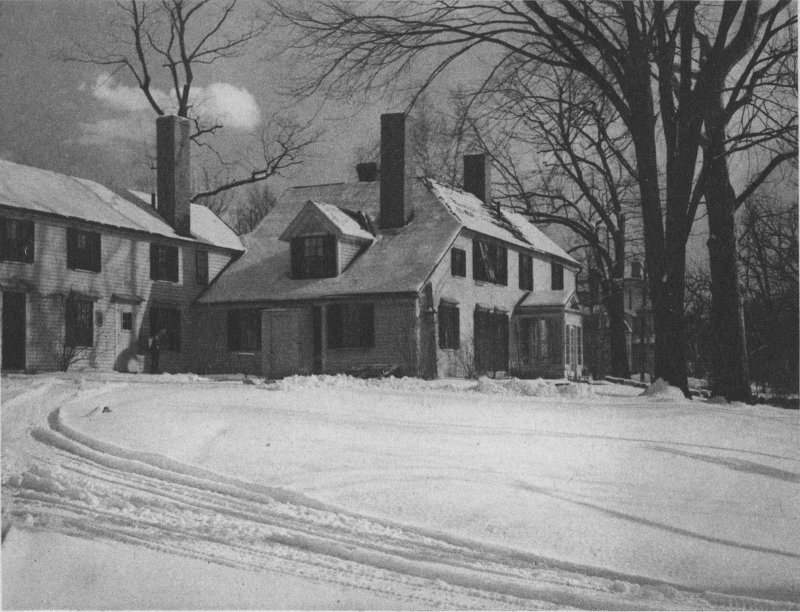
THE BULLET-HOLE HOUSE, HOME OF MINUTEMAN ELISHA JONES
The oldest portion of this house, overlooking North Bridge, dates from 1644, making it probably the oldest house in Concord. Elisha Jones, Concord minuteman, was guarding military supplies in his house when the British began their retreat. He imprudently showed himself at the door of the left wing, and was promptly fired upon. The bullet missed him, and the hole it made is still preserved under a pane of glass.

THE OLD MANSE (view from the northwest)
This large gambrel-roofed homestead was built in 1769 by the Reverend William Emerson, Concord’s fighting minister. Its grounds border the Concord River, and the minister is said to have viewed the battle at North Bridge from the window of his study. His grandson, Ralph Waldo Emerson, spent much time in the old house as a schoolboy, and later lived here for a year, writing “Nature” during that period. Nathaniel Hawthorne rented the house in 1842, and brought his bride there, to occupy it for some four years. It was Hawthorne who named it “The Old Manse,” and it was his “Mosses from an Old Manse” that made it known to the world. The house has undergone astonishingly little change since it was built 170 years ago.
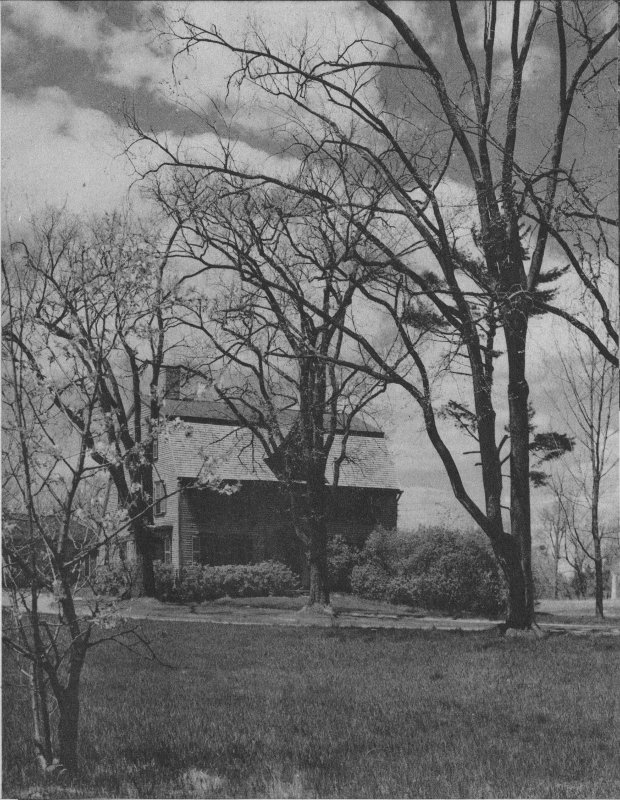
EARLY SPRING AT THE OLD MANSE

THE BATTLEGROUND, CONCORD
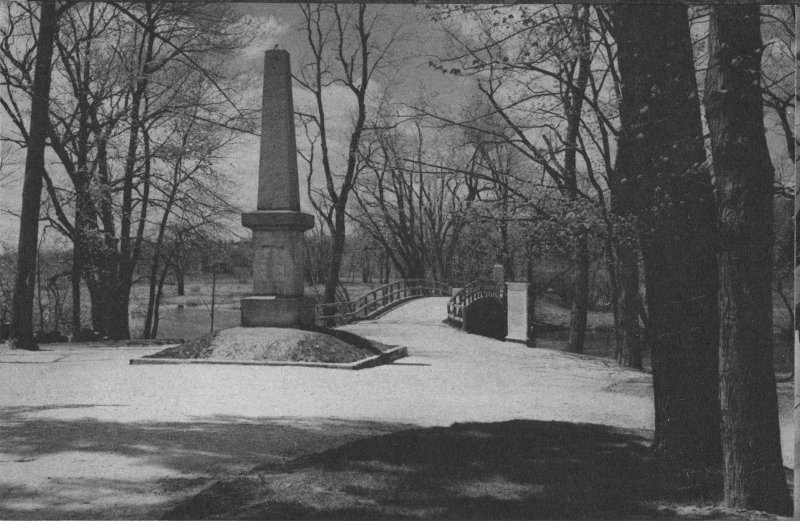
THE GRANITE OBELISK AND THE NORTH BRIDGE, CONCORD
The Battleground by North Bridge is marked by this monument, erected in 1836. Nearby is a tablet marking the graves of two British soldiers killed in the fight. The present bridge is a concrete copy of the original wooden bridge, abandoned in 1794. Here was fired the “shot that was heard round the world.” Here is the setting of Longfellow’s immortal poem. Here was the turning point in America’s struggle for independence.

THE MINUTEMAN, CONCORD
“The Minuteman,” first important Statue by Daniel Chester French, stands guard over the Battleground. The spirited young farmer is leaving his plow to answer the alarm, musket in hand. The sculptor, unable to afford a living model, is said to have used a statue of Apollo Belvedere dressed as a minuteman for the purpose. The scene of this bloody and momentous battle is now the picture of calm repose, and a shrine for innumerable visitors.
The Story of the battle is eloquently related by a tablet on the scene:
CONCORD FIGHT
“On the morning of April Nineteenth, 1775, while the British held this bridge, the minutemen and militia of Concord and neighboring towns gathered on the hill across the river. There the Concord Adjutant, Joseph Hosmer, demanded, ‘Will you let them burn the town down?’ There the Lincoln captain, William Smith, offered to dislodge the British, the Acton captain, Isaac Davis, said, ‘I haven’t a man that’s afraid to go!’ and the Concord colonel, James Barrett, ordered the attack upon the regulars.
The column was led by Major John Buttrick, marching from his own farm. His aide was Lt. Colonel John Robinson of Westford. The minutemen of Acton, Concord, Lincoln and Bedford followed, after them came the militia. At the British volley, Isaac Davis fell. Buttrick cried, ‘Fire, fellow-soldiers, for God’s sake Fire!’ and himself fired first. The British fled; and here began the separation of two kindred nations, now happily long united in peace.”
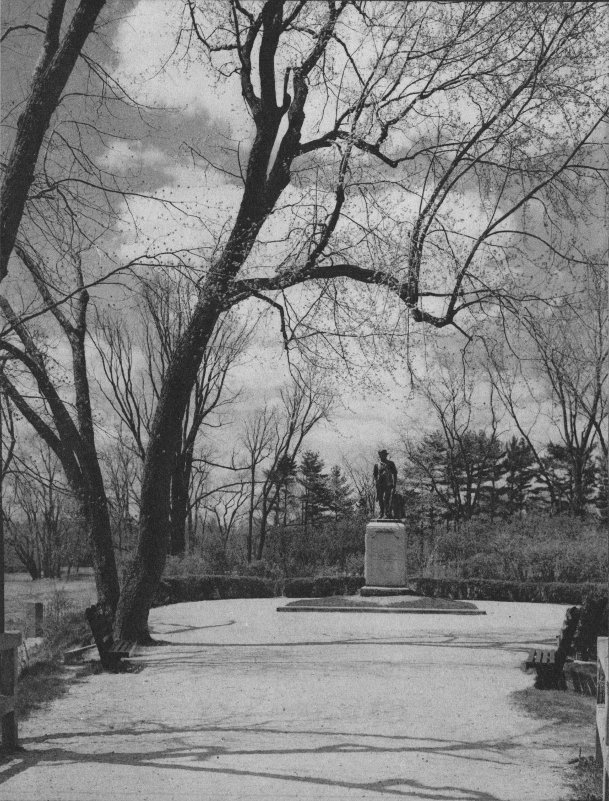
THE “MINUTEMAN” IN A SPRINGTIME SETTING

NORTH BRIDGE, CONCORD
End of Project Gutenberg's Lexington and Concord, by Samuel V. Chamberlain
*** END OF THIS PROJECT GUTENBERG EBOOK LEXINGTON AND CONCORD ***
***** This file should be named 57529-h.htm or 57529-h.zip *****
This and all associated files of various formats will be found in:
http://www.gutenberg.org/5/7/5/2/57529/
Produced by Stephen Hutcheson and the Online Distributed
Proofreading Team at http://www.pgdp.net
Updated editions will replace the previous one--the old editions will
be renamed.
Creating the works from print editions not protected by U.S. copyright
law means that no one owns a United States copyright in these works,
so the Foundation (and you!) can copy and distribute it in the United
States without permission and without paying copyright
royalties. Special rules, set forth in the General Terms of Use part
of this license, apply to copying and distributing Project
Gutenberg-tm electronic works to protect the PROJECT GUTENBERG-tm
concept and trademark. Project Gutenberg is a registered trademark,
and may not be used if you charge for the eBooks, unless you receive
specific permission. If you do not charge anything for copies of this
eBook, complying with the rules is very easy. You may use this eBook
for nearly any purpose such as creation of derivative works, reports,
performances and research. They may be modified and printed and given
away--you may do practically ANYTHING in the United States with eBooks
not protected by U.S. copyright law. Redistribution is subject to the
trademark license, especially commercial redistribution.
START: FULL LICENSE
THE FULL PROJECT GUTENBERG LICENSE
PLEASE READ THIS BEFORE YOU DISTRIBUTE OR USE THIS WORK
To protect the Project Gutenberg-tm mission of promoting the free
distribution of electronic works, by using or distributing this work
(or any other work associated in any way with the phrase "Project
Gutenberg"), you agree to comply with all the terms of the Full
Project Gutenberg-tm License available with this file or online at
www.gutenberg.org/license.
Section 1. General Terms of Use and Redistributing Project
Gutenberg-tm electronic works
1.A. By reading or using any part of this Project Gutenberg-tm
electronic work, you indicate that you have read, understand, agree to
and accept all the terms of this license and intellectual property
(trademark/copyright) agreement. If you do not agree to abide by all
the terms of this agreement, you must cease using and return or
destroy all copies of Project Gutenberg-tm electronic works in your
possession. If you paid a fee for obtaining a copy of or access to a
Project Gutenberg-tm electronic work and you do not agree to be bound
by the terms of this agreement, you may obtain a refund from the
person or entity to whom you paid the fee as set forth in paragraph
1.E.8.
1.B. "Project Gutenberg" is a registered trademark. It may only be
used on or associated in any way with an electronic work by people who
agree to be bound by the terms of this agreement. There are a few
things that you can do with most Project Gutenberg-tm electronic works
even without complying with the full terms of this agreement. See
paragraph 1.C below. There are a lot of things you can do with Project
Gutenberg-tm electronic works if you follow the terms of this
agreement and help preserve free future access to Project Gutenberg-tm
electronic works. See paragraph 1.E below.
1.C. The Project Gutenberg Literary Archive Foundation ("the
Foundation" or PGLAF), owns a compilation copyright in the collection
of Project Gutenberg-tm electronic works. Nearly all the individual
works in the collection are in the public domain in the United
States. If an individual work is unprotected by copyright law in the
United States and you are located in the United States, we do not
claim a right to prevent you from copying, distributing, performing,
displaying or creating derivative works based on the work as long as
all references to Project Gutenberg are removed. Of course, we hope
that you will support the Project Gutenberg-tm mission of promoting
free access to electronic works by freely sharing Project Gutenberg-tm
works in compliance with the terms of this agreement for keeping the
Project Gutenberg-tm name associated with the work. You can easily
comply with the terms of this agreement by keeping this work in the
same format with its attached full Project Gutenberg-tm License when
you share it without charge with others.
1.D. The copyright laws of the place where you are located also govern
what you can do with this work. Copyright laws in most countries are
in a constant state of change. If you are outside the United States,
check the laws of your country in addition to the terms of this
agreement before downloading, copying, displaying, performing,
distributing or creating derivative works based on this work or any
other Project Gutenberg-tm work. The Foundation makes no
representations concerning the copyright status of any work in any
country outside the United States.
1.E. Unless you have removed all references to Project Gutenberg:
1.E.1. The following sentence, with active links to, or other
immediate access to, the full Project Gutenberg-tm License must appear
prominently whenever any copy of a Project Gutenberg-tm work (any work
on which the phrase "Project Gutenberg" appears, or with which the
phrase "Project Gutenberg" is associated) is accessed, displayed,
performed, viewed, copied or distributed:
This eBook is for the use of anyone anywhere in the United States and
most other parts of the world at no cost and with almost no
restrictions whatsoever. You may copy it, give it away or re-use it
under the terms of the Project Gutenberg License included with this
eBook or online at www.gutenberg.org. If you are not located in the
United States, you'll have to check the laws of the country where you
are located before using this ebook.
1.E.2. If an individual Project Gutenberg-tm electronic work is
derived from texts not protected by U.S. copyright law (does not
contain a notice indicating that it is posted with permission of the
copyright holder), the work can be copied and distributed to anyone in
the United States without paying any fees or charges. If you are
redistributing or providing access to a work with the phrase "Project
Gutenberg" associated with or appearing on the work, you must comply
either with the requirements of paragraphs 1.E.1 through 1.E.7 or
obtain permission for the use of the work and the Project Gutenberg-tm
trademark as set forth in paragraphs 1.E.8 or 1.E.9.
1.E.3. If an individual Project Gutenberg-tm electronic work is posted
with the permission of the copyright holder, your use and distribution
must comply with both paragraphs 1.E.1 through 1.E.7 and any
additional terms imposed by the copyright holder. Additional terms
will be linked to the Project Gutenberg-tm License for all works
posted with the permission of the copyright holder found at the
beginning of this work.
1.E.4. Do not unlink or detach or remove the full Project Gutenberg-tm
License terms from this work, or any files containing a part of this
work or any other work associated with Project Gutenberg-tm.
1.E.5. Do not copy, display, perform, distribute or redistribute this
electronic work, or any part of this electronic work, without
prominently displaying the sentence set forth in paragraph 1.E.1 with
active links or immediate access to the full terms of the Project
Gutenberg-tm License.
1.E.6. You may convert to and distribute this work in any binary,
compressed, marked up, nonproprietary or proprietary form, including
any word processing or hypertext form. However, if you provide access
to or distribute copies of a Project Gutenberg-tm work in a format
other than "Plain Vanilla ASCII" or other format used in the official
version posted on the official Project Gutenberg-tm web site
(www.gutenberg.org), you must, at no additional cost, fee or expense
to the user, provide a copy, a means of exporting a copy, or a means
of obtaining a copy upon request, of the work in its original "Plain
Vanilla ASCII" or other form. Any alternate format must include the
full Project Gutenberg-tm License as specified in paragraph 1.E.1.
1.E.7. Do not charge a fee for access to, viewing, displaying,
performing, copying or distributing any Project Gutenberg-tm works
unless you comply with paragraph 1.E.8 or 1.E.9.
1.E.8. You may charge a reasonable fee for copies of or providing
access to or distributing Project Gutenberg-tm electronic works
provided that
* You pay a royalty fee of 20% of the gross profits you derive from
the use of Project Gutenberg-tm works calculated using the method
you already use to calculate your applicable taxes. The fee is owed
to the owner of the Project Gutenberg-tm trademark, but he has
agreed to donate royalties under this paragraph to the Project
Gutenberg Literary Archive Foundation. Royalty payments must be paid
within 60 days following each date on which you prepare (or are
legally required to prepare) your periodic tax returns. Royalty
payments should be clearly marked as such and sent to the Project
Gutenberg Literary Archive Foundation at the address specified in
Section 4, "Information about donations to the Project Gutenberg
Literary Archive Foundation."
* You provide a full refund of any money paid by a user who notifies
you in writing (or by e-mail) within 30 days of receipt that s/he
does not agree to the terms of the full Project Gutenberg-tm
License. You must require such a user to return or destroy all
copies of the works possessed in a physical medium and discontinue
all use of and all access to other copies of Project Gutenberg-tm
works.
* You provide, in accordance with paragraph 1.F.3, a full refund of
any money paid for a work or a replacement copy, if a defect in the
electronic work is discovered and reported to you within 90 days of
receipt of the work.
* You comply with all other terms of this agreement for free
distribution of Project Gutenberg-tm works.
1.E.9. If you wish to charge a fee or distribute a Project
Gutenberg-tm electronic work or group of works on different terms than
are set forth in this agreement, you must obtain permission in writing
from both the Project Gutenberg Literary Archive Foundation and The
Project Gutenberg Trademark LLC, the owner of the Project Gutenberg-tm
trademark. Contact the Foundation as set forth in Section 3 below.
1.F.
1.F.1. Project Gutenberg volunteers and employees expend considerable
effort to identify, do copyright research on, transcribe and proofread
works not protected by U.S. copyright law in creating the Project
Gutenberg-tm collection. Despite these efforts, Project Gutenberg-tm
electronic works, and the medium on which they may be stored, may
contain "Defects," such as, but not limited to, incomplete, inaccurate
or corrupt data, transcription errors, a copyright or other
intellectual property infringement, a defective or damaged disk or
other medium, a computer virus, or computer codes that damage or
cannot be read by your equipment.
1.F.2. LIMITED WARRANTY, DISCLAIMER OF DAMAGES - Except for the "Right
of Replacement or Refund" described in paragraph 1.F.3, the Project
Gutenberg Literary Archive Foundation, the owner of the Project
Gutenberg-tm trademark, and any other party distributing a Project
Gutenberg-tm electronic work under this agreement, disclaim all
liability to you for damages, costs and expenses, including legal
fees. YOU AGREE THAT YOU HAVE NO REMEDIES FOR NEGLIGENCE, STRICT
LIABILITY, BREACH OF WARRANTY OR BREACH OF CONTRACT EXCEPT THOSE
PROVIDED IN PARAGRAPH 1.F.3. YOU AGREE THAT THE FOUNDATION, THE
TRADEMARK OWNER, AND ANY DISTRIBUTOR UNDER THIS AGREEMENT WILL NOT BE
LIABLE TO YOU FOR ACTUAL, DIRECT, INDIRECT, CONSEQUENTIAL, PUNITIVE OR
INCIDENTAL DAMAGES EVEN IF YOU GIVE NOTICE OF THE POSSIBILITY OF SUCH
DAMAGE.
1.F.3. LIMITED RIGHT OF REPLACEMENT OR REFUND - If you discover a
defect in this electronic work within 90 days of receiving it, you can
receive a refund of the money (if any) you paid for it by sending a
written explanation to the person you received the work from. If you
received the work on a physical medium, you must return the medium
with your written explanation. The person or entity that provided you
with the defective work may elect to provide a replacement copy in
lieu of a refund. If you received the work electronically, the person
or entity providing it to you may choose to give you a second
opportunity to receive the work electronically in lieu of a refund. If
the second copy is also defective, you may demand a refund in writing
without further opportunities to fix the problem.
1.F.4. Except for the limited right of replacement or refund set forth
in paragraph 1.F.3, this work is provided to you 'AS-IS', WITH NO
OTHER WARRANTIES OF ANY KIND, EXPRESS OR IMPLIED, INCLUDING BUT NOT
LIMITED TO WARRANTIES OF MERCHANTABILITY OR FITNESS FOR ANY PURPOSE.
1.F.5. Some states do not allow disclaimers of certain implied
warranties or the exclusion or limitation of certain types of
damages. If any disclaimer or limitation set forth in this agreement
violates the law of the state applicable to this agreement, the
agreement shall be interpreted to make the maximum disclaimer or
limitation permitted by the applicable state law. The invalidity or
unenforceability of any provision of this agreement shall not void the
remaining provisions.
1.F.6. INDEMNITY - You agree to indemnify and hold the Foundation, the
trademark owner, any agent or employee of the Foundation, anyone
providing copies of Project Gutenberg-tm electronic works in
accordance with this agreement, and any volunteers associated with the
production, promotion and distribution of Project Gutenberg-tm
electronic works, harmless from all liability, costs and expenses,
including legal fees, that arise directly or indirectly from any of
the following which you do or cause to occur: (a) distribution of this
or any Project Gutenberg-tm work, (b) alteration, modification, or
additions or deletions to any Project Gutenberg-tm work, and (c) any
Defect you cause.
Section 2. Information about the Mission of Project Gutenberg-tm
Project Gutenberg-tm is synonymous with the free distribution of
electronic works in formats readable by the widest variety of
computers including obsolete, old, middle-aged and new computers. It
exists because of the efforts of hundreds of volunteers and donations
from people in all walks of life.
Volunteers and financial support to provide volunteers with the
assistance they need are critical to reaching Project Gutenberg-tm's
goals and ensuring that the Project Gutenberg-tm collection will
remain freely available for generations to come. In 2001, the Project
Gutenberg Literary Archive Foundation was created to provide a secure
and permanent future for Project Gutenberg-tm and future
generations. To learn more about the Project Gutenberg Literary
Archive Foundation and how your efforts and donations can help, see
Sections 3 and 4 and the Foundation information page at
www.gutenberg.org
Section 3. Information about the Project Gutenberg Literary Archive Foundation
The Project Gutenberg Literary Archive Foundation is a non profit
501(c)(3) educational corporation organized under the laws of the
state of Mississippi and granted tax exempt status by the Internal
Revenue Service. The Foundation's EIN or federal tax identification
number is 64-6221541. Contributions to the Project Gutenberg Literary
Archive Foundation are tax deductible to the full extent permitted by
U.S. federal laws and your state's laws.
The Foundation's principal office is in Fairbanks, Alaska, with the
mailing address: PO Box 750175, Fairbanks, AK 99775, but its
volunteers and employees are scattered throughout numerous
locations. Its business office is located at 809 North 1500 West, Salt
Lake City, UT 84116, (801) 596-1887. Email contact links and up to
date contact information can be found at the Foundation's web site and
official page at www.gutenberg.org/contact
For additional contact information:
Dr. Gregory B. Newby
Chief Executive and Director
gbnewby@pglaf.org
Section 4. Information about Donations to the Project Gutenberg
Literary Archive Foundation
Project Gutenberg-tm depends upon and cannot survive without wide
spread public support and donations to carry out its mission of
increasing the number of public domain and licensed works that can be
freely distributed in machine readable form accessible by the widest
array of equipment including outdated equipment. Many small donations
($1 to $5,000) are particularly important to maintaining tax exempt
status with the IRS.
The Foundation is committed to complying with the laws regulating
charities and charitable donations in all 50 states of the United
States. Compliance requirements are not uniform and it takes a
considerable effort, much paperwork and many fees to meet and keep up
with these requirements. We do not solicit donations in locations
where we have not received written confirmation of compliance. To SEND
DONATIONS or determine the status of compliance for any particular
state visit www.gutenberg.org/donate
While we cannot and do not solicit contributions from states where we
have not met the solicitation requirements, we know of no prohibition
against accepting unsolicited donations from donors in such states who
approach us with offers to donate.
International donations are gratefully accepted, but we cannot make
any statements concerning tax treatment of donations received from
outside the United States. U.S. laws alone swamp our small staff.
Please check the Project Gutenberg Web pages for current donation
methods and addresses. Donations are accepted in a number of other
ways including checks, online payments and credit card donations. To
donate, please visit: www.gutenberg.org/donate
Section 5. General Information About Project Gutenberg-tm electronic works.
Professor Michael S. Hart was the originator of the Project
Gutenberg-tm concept of a library of electronic works that could be
freely shared with anyone. For forty years, he produced and
distributed Project Gutenberg-tm eBooks with only a loose network of
volunteer support.
Project Gutenberg-tm eBooks are often created from several printed
editions, all of which are confirmed as not protected by copyright in
the U.S. unless a copyright notice is included. Thus, we do not
necessarily keep eBooks in compliance with any particular paper
edition.
Most people start at our Web site which has the main PG search
facility: www.gutenberg.org
This Web site includes information about Project Gutenberg-tm,
including how to make donations to the Project Gutenberg Literary
Archive Foundation, how to help produce our new eBooks, and how to
subscribe to our email newsletter to hear about new eBooks.